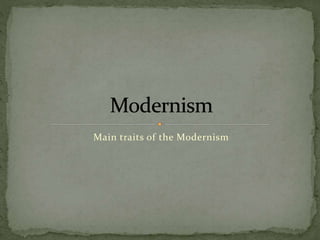The document discusses several key traits of Modernist literature:
- Modernist writers were fascinated with how individuals adapted to a changing world and often depicted characters struggling to stay afloat.
- The carnage of World War I and II profoundly impacted writers and contributed to a sense that the world had become absurd. Modernist works often depicted this absurdity.
- Modernist writers infused symbols and hidden meanings into their works, leaving more open to interpretation than earlier writers. Works had multiple layers and interpretations.
- Writers saw literature as a craft constructed of parts rather than an organic process, which fed their desire for originality and experimentation. Modernist works frequently broke conventions.











![ As well as being among the most significant poets of his time, Pound had a talent for attracting attention. This gift served him well in the early years, when he could pretend to
discover rules for making immortal poetry. What he was actually doing was describing the poems he liked and that he and his immediate circle had already written. Clever guy.
In 1912-1913, Pound embraced or invented imagism. Imagism had three major criteria: It had to be
direct and unornamented,
economical in its language,
and composed in free verse (or at least not in any forms of the immediate past).
Pound first branded his lover, the poet H.D. (Hilda Doolittle), who had grown up with him in Pittsburgh, as an "Imagiste." Notice the pretentious spelling! By his criteria, her
poems seem to fit. But we can't really say that of others who associated themselves with this short-lived school of poetry.
Though we might tend to use the word "image" interchangeably with "metaphor" or "simile," Pound had something much larger and more complex than this in mind. Pound's
definition of an image as "that which presents an intellectual and emotional complex in an instant of time." D-dang, Pound.
So basically: in a very small space of time an artwork should connect many different ideas that had not been connected up to that point in a new way that would spark
emotional and psychological insight. It should also totally change the way people would view the world and the way they would feel about it too. Not too tall an order, right?
Sounds easy enough?
By 1914, Imagism (though not the images themselves) had lost its luster for Pound. Too many boring people he'd rather not be associated with were flying this banner. So he cut
himself loose from Imagism and now proclaimed himself and the visual artists, musicians, sculptors, and writers he embraced to be Vorticists.
Pound founded a journal, Blast, in June of 1914 to present the works associated with this movement.
The characteristics of Vorticism—which sounds kind of sci-fi to us—sound a lot like those of Imagism, though the description of Vorticism referred toall the arts, and not just
poetry. Pound described a vortex as "a radiant node or cluster […] from which and into which ideas are constantly rushing." Sounds like a hurricane or a black hole.
What's our takeaway from all this (besides that the all-important strategy of rebranding can apply even to poets)? Simple: cram as many ideas, as beautifully as possible, into
your artwork.
Chew On This
With some judicious editing by Pound, the poem "Oread," by H.D. becomes the definition of an Imagist poem. In fact, it was while Pound was reading through H.D.'s poetry
that he first got the idea for Imagism in the first place. Psst: also, H.D. and Pound were totally smooching.
Compare "Oread" to H.D.'s poem to Pound's "In a Station of the Metro." Do the language and imagery](https://image.slidesharecdn.com/modernism-180410203936/85/Modernism-12-320.jpg)



